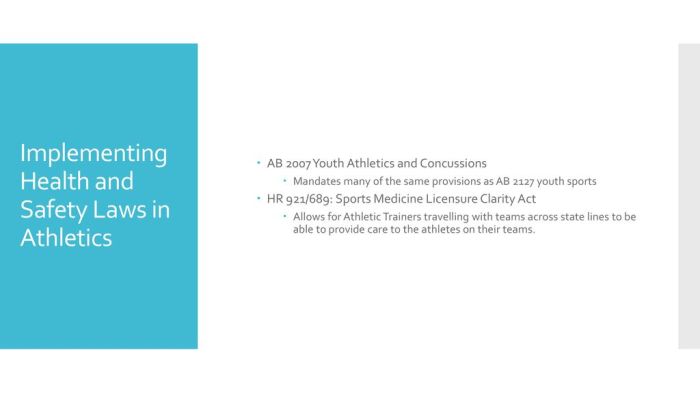The Sports Medicine Licensure Clarity Act (SMLCA) is a transformative piece of legislation that has significantly impacted the field of sports medicine. Enacted in 2018, this act aims to establish clear standards and enhance regulation for sports medicine practitioners, ensuring the delivery of high-quality care to athletes and individuals engaged in physical activity.
The SMLCA addresses a range of important issues, including the scope of practice for sports medicine practitioners, licensure and certification requirements, education and training standards, and regulation and enforcement mechanisms. By addressing these key areas, the act aims to enhance patient safety, improve the quality of sports medicine services, and promote the professional development of sports medicine practitioners.
Overview of the Sports Medicine Licensure Clarity Act

The Sports Medicine Licensure Clarity Act (SMLCA) is a federal law enacted in 2020 to establish national standards for the licensure and regulation of sports medicine practitioners. The Act aims to ensure the competency and quality of care provided by sports medicine professionals and protect the public from unqualified practitioners.The
SMLCA was developed in response to the growing demand for sports medicine services and the increasing complexity of sports injuries and illnesses. Before the Act’s enactment, the licensure and regulation of sports medicine practitioners varied significantly across states, leading to confusion and inconsistency in the profession.
Scope of Practice for Sports Medicine Practitioners: Sports Medicine Licensure Clarity Act

The SMLCA defines the scope of practice for sports medicine practitioners as the provision of healthcare services to individuals who are involved in sports or physical activity. This includes the diagnosis, treatment, and prevention of injuries and illnesses related to sports and physical activity.Sports
medicine practitioners may work in a variety of settings, including hospitals, clinics, sports teams, and fitness centers. They may provide services to athletes of all ages and skill levels, from recreational athletes to professional athletes.
Licensure and Certification Requirements
The SMLCA requires all sports medicine practitioners to be licensed or certified in their state of practice. The specific requirements vary by state, but generally include:
- Completion of an accredited education program in sports medicine
- Passing a national certification exam
- Maintaining continuing education credits
Education and Training Standards
The SMLCA sets minimum education and training standards for sports medicine practitioners. Accredited education programs must include coursework in:
- Anatomy and physiology
- Exercise science
- Nutrition
- Sports psychology
- Injury prevention and treatment
- Rehabilitation
Regulation and Enforcement, Sports medicine licensure clarity act
The SMLCA gives states the authority to regulate the practice of sports medicine. States may establish their own licensure and certification requirements, as well as disciplinary actions for violations of the Act.The SMLCA also creates a national oversight committee to monitor the implementation of the Act and ensure that states are complying with its provisions.
Impact on the Sports Medicine Profession
The SMLCA has had a significant impact on the sports medicine profession. The Act has:
- Established national standards for the licensure and regulation of sports medicine practitioners
- Improved the quality of care provided by sports medicine professionals
- Protected the public from unqualified practitioners
- Increased the visibility and recognition of the sports medicine profession
Comparison with Other Healthcare Professions
The SMLCA is similar to other laws that regulate healthcare professions, such as the Nurse Licensure Compact and the Physical Therapy Licensure Compact. These laws aim to ensure the competency and quality of care provided by healthcare professionals and protect the public from unqualified practitioners.However,
the SMLCA is unique in that it is the first federal law to specifically regulate the practice of sports medicine. This reflects the growing importance of sports medicine in the United States and the need for national standards to ensure the safety and well-being of athletes.
FAQ Section
What is the purpose of the Sports Medicine Licensure Clarity Act?
The SMLCA aims to establish clear standards and enhance regulation for sports medicine practitioners to ensure the delivery of high-quality care to athletes and individuals engaged in physical activity.
Who is covered under the SMLCA?
The SMLCA covers healthcare professionals who provide sports medicine services, including physicians, physical therapists, athletic trainers, and chiropractors.
What are the licensure and certification requirements for sports medicine practitioners?
The SMLCA establishes specific licensure and certification requirements for sports medicine practitioners, depending on their profession and scope of practice.
How does the SMLCA impact the education and training of sports medicine practitioners?
The SMLCA sets forth education and training standards for sports medicine practitioners, ensuring they possess the necessary knowledge and skills to provide safe and effective care.
What are the enforcement mechanisms in place to ensure compliance with the SMLCA?
Regulatory bodies oversee the practice of sports medicine and enforce the SMLCA through disciplinary actions and penalties to ensure compliance with the act’s provisions.

